The year 2017 has not gotten off to a great start for Syrian refugees hoping to be resettled in Europe and the United States – or anywhere else, for that matter.
One of the defining features of the Trump presidency thus far has been the so-called “Muslim ban,” which lays out a 120-day ban on all refugees from seven Muslim-majority countries entering the United States. Europe is also experiencing a rise in populist and xenophobic sentiment, and EU nations are being forced by their constituents to consider further limiting the number of refugees they resettle.
In today’s fragile global political environment, increasing resettlement opportunities in Latin America could be the best possible solution.
The move would not be completely unprecedented. Historically, Latin American countries have accepted many asylum seekers and refugees from neighboring countries fraught with drug violence and civil war. They have also taken refugees from Europe. During the Spanish Civil War and during and after World War II, many Spaniards, Germans, and European Jews fled to South America. Years later in 1984, ten major Latin American countries signed the groundbreaking Cartagena Declaration on Refugees, which gave the region a much-needed protection framework for refugees.
Countries like Brazil are already quite diverse, with a mostly African, indigenous, and European population, as well as many ethnic Syrians and Lebanese whose ancestors emigrated in the late 19th century. In 2012, Brazil launched a humanitarian visa program for individuals fleeing the Syrian conflict. As of July 2016, the country had about 2,100 Syrian refugees, more than any other country in Latin America. By the end of 2015, Brazil was also hosting over 7,000 refugees from Jordan, Turkey, and Lebanon.
Brazil’s diverse population also contributes to a relative lack of anti-immigrant sentiment. Oliver Stuenkel, an assistant professor of international relations at Fundação Getulio Vargas in São Paulo, Brazil, estimates that the country could take in 50,000 Syrian refugees without experiencing a surge of xenophobia.
Argentina also has a large Arab minority population. Syrian and Lebanese immigrants and their descendants made up 10% of the population in 2014. At the end of 2016, the country announced plans to accept 300 Syrian refugees. As of 2014, Colombia, a country better known for creating refugees than for receiving them, had accepted all asylum applications it had received from Syrians (though admittedly, there were only 19). That same year, the tiny country of Uruguay, with a population of only 3.4 million, announced a plan to resettle 120 Syrians. At the time, this was about the same number of refugees resettled in Spain, a country with a population roughly 14 times that of Uruguay’s. In 2015, Chile offered to take 100 Syrian families. For its part, Venezuela has pledged to take in 20,000 Syrian refugees.
A new UN venture hopes to greatly boost these numbers in coming years. The new program, called the Emerging Resettlement Countries Joint Support Mechanism (ERCM), seeks to have richer nations provide money and aid for the development of infrastructure to help countries in Latin America and Asia support refugees. The support mechanism, announced in September 2016, aims to resettle 30,000 refugees in its first three years by assisting countries in the resettlement process. ERCM will require an initial budget of about $115 million, of which British Prime Minister Theresa May has pledged £30 million (over $38 million). Although former US President Barack Obama pledged $11 million, it is unclear at the time of writing how President Trump’s proposed cuts to the UN would affect this promise.
However, while large-scale resettlement in Latin America is possible, there are several challenges. Brazil’s former president, Dilma Rousseff, criticized European leaders for their treatment of refugees and asylum seekers and promised to accept 100,000 Syrian refugees over five years – but her impeachment last year drastically changed the situation. The new right-leaning government ended talks about the pledge amid cost-cutting measures in a struggling economy. And a year after Uruguay resettled 42 out of its pledged 120 Syrian refugees, the refugees protested in front of the presidential palace and asked to leave the country, citing social isolation and difficulty finding jobs. Uruguay’s population is less diverse than its neighbors, and has no official mosque.
Meanwhile, Venezuela’s offer to resettle 20,000 refugees was likely a publicity stunt by the flailing government, and few refugees are likely to want to be resettled there given its political instability, poverty, and food insecurity.
Despite these problems, Latin America presents a promising opportunity to resettle some of the more than five million Syrian refugees trapped in camps and urban slums in Europe, Turkey, and the Levant who are living without access to quality education or employment. Refugees could contribute skilled labor and new ideas to stagnant economies in Latin America. If the ERCM initiative is successful, it could help stabilize some of the more fragile economies in the region, providing opportunities for nationals and Syrians alike.
The initiative could also help alleviate tensions in Europe, where fears over the large number of migrants, coupled with waves of terrorist attacks, have caused a surge of xenophobia and Islamophobia.
And for the refugees themselves, more resettlement opportunities would allow them to get their lives back on track, rather than languishing in camps. Supporting the ERCM, with a particular emphasis on countries with a large Syrian diaspora such as Brazil and Argentina, is a win-win for all parties involved.
